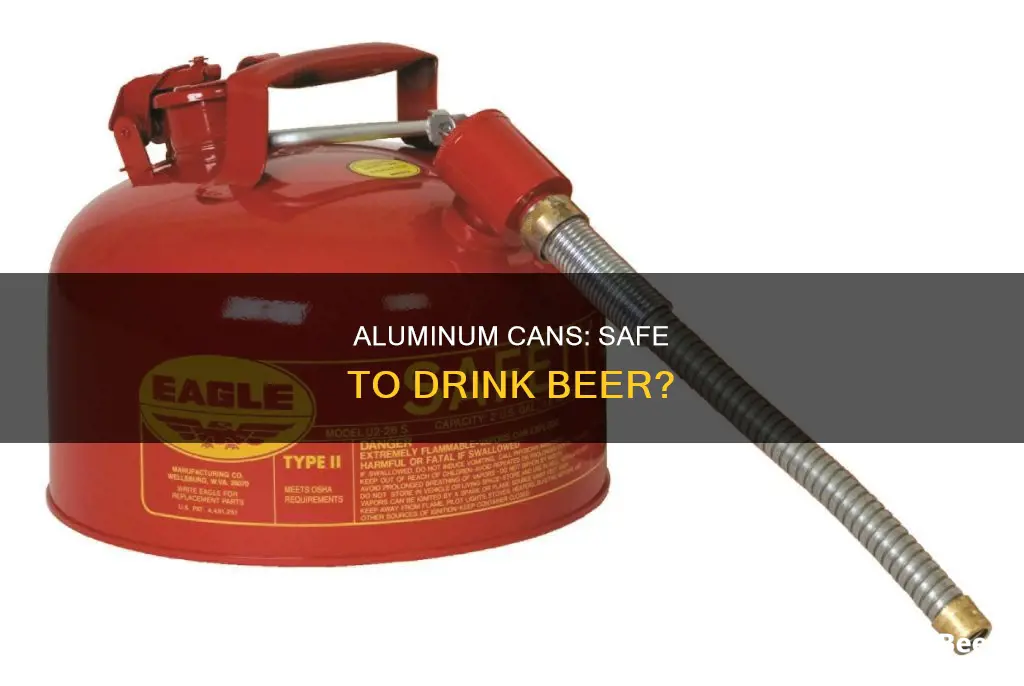
Beer cans are lined with epoxy that contains bisphenol A (BPA), a chemical that keeps food from reacting with aluminium. However, BPA has been associated with a range of health problems, including cancer, reproductive issues, and irregular brain development in children. While the Food and Drug Administration (FDA) has deemed BPA safe at current levels in food, some researchers argue that more research is needed to understand the potential health risks associated with consuming BPA-lined cans. Additionally, concerns have been raised about the presence of microbes and bacteria on the outside of cans, which could contaminate the beer when the can is opened.
What You'll Learn

Aluminium toxicity
The EFSA (European Food Safety Authority) has set a maximum safe weekly dose of aluminium at 1 mg/kg, but estimates suggest that a significant portion of Europeans exceed this limit, with exposure ranging from 0.2 to 1.5 mg/kg/week.
Aluminium production is also hazardous for workers, as the process has been classified as a definite human carcinogen, increasing the risk of lung and bladder cancer.
Furthermore, the plastic lining inside beer cans, which protects the beer from direct contact with aluminium, is made of bisphenol A (BPA), a well-known endocrine disruptor. BPA has been linked to various health issues, including cancer, reproductive problems, and irregular brain development in children. While some countries have banned BPA from food packaging, its safety remains controversial, and it has been detected in canned beer.
To minimise the risk of aluminium toxicity and exposure to BPA, consumers may consider choosing glass bottles over cans for their beer, especially reusable glass bottles, which are also more environmentally friendly.
Beer Drinking: A Daily Habit That Can Kill You
You may want to see also

Bisphenol A (BPA)
BPA is biologically similar to estrogen, and so it can interfere with the body's hormonal processes, including the reproductive and nervous systems, as well as behavioural development. It is particularly dangerous for infants, who have underdeveloped digestive systems. Due to these risks, the US Food and Drug Administration (FDA) has banned the use of BPA in baby bottles, sippy cups, and packaging for infant formula. However, the FDA has approved the use of BPA in cans, stating that it is "safe at the current levels occurring in foods".
Despite this, there is ongoing controversy surrounding the use of BPA, with some scientists arguing that low-level exposure to BPA can lead to serious health problems, including cancer, insulin-resistant diabetes, obesity, and attention-deficit disorder. Studies have shown that BPA can leach from can linings into food and drinks, including beer. One study found that participants who consumed canned soup for five days had a 1,000% increase in urinary BPA concentrations compared to when they consumed fresh soup. Another study found that participants who drank canned soy milk had a 1,600% increase in urinary BPA levels and experienced increased blood pressure.
While the health effects of BPA exposure are still being studied, some companies have started to move away from using BPA in their products. However, the canning industry claims that they have not yet found a viable alternative that works as well as a resin coating or is commercially viable.
Expired Beer: Is It Safe to Drink?
You may want to see also

Microbial contamination
Aluminium cans are lined with a thin plastic film that contains bisphenol A (BPA), a chemical that prevents food from reacting with the aluminium. However, BPA is associated with a range of health issues, including cancer, reproductive trouble, and irregular brain development in children. It is also an endocrine disruptor, meaning it can cause hormonal damage even at extremely low levels.
While the Food and Drug Administration (FDA) has declared that BPA is safe at current levels found in foods, this decision is controversial among scientists. Some studies have shown that low-level exposure to BPA can lead to serious health problems, and it has been banned in France.
Beverage cans can also be a source of microbial contamination. A study found that 46.39% of 194 randomly selected cans were in the dangerous unsanitary category, with high levels of bacteria on the lids. Another study reported that soda can tops had one of the highest levels of bacteria for a variety of surfaces humans are exposed to daily, including toilet seats and ATM keypads.
Contamination can occur during production, storage, and shipping, as microorganisms may come into contact with the lids. When drinking directly from a can, one's mouth comes into direct contact with the lid, allowing for the possible transfer of these microorganisms.
To reduce the risk of microbial contamination, it is recommended to wipe off the top of the can before opening it, preferably with a clean cloth or napkin.
Richard Rawlings' Beer Drinking: Fact or Fiction?
You may want to see also

Rat urine contamination
Drinking from an aluminium can that has been contaminated with rat urine can be fatal. The myth of a woman who died from Leptospirosis, allegedly caused by drinking from an aluminium can contaminated with dried rat urine, has been debunked. However, it is important to be cautious as the outside of cans can be exposed to germs and bacteria.
Jason Tetro, a microbiologist and author of The Germ Files, advises that it is not necessary to stop drinking from cans altogether. While there may be faecal matter on the rim of a can, it is important to remember that germs are everywhere. Even if there is some contamination, most of the bacteria will likely be dead, and the small amount of live germs would not be enough to cause illness. Additionally, by tipping the can and releasing the liquid, you create a dilution effect that further reduces the risk of bacterial harm.
To further reduce the risk of contamination, it is recommended to wipe off the top of the can before opening it, preferably with a clean cloth. While there have been concerns about the aluminium and BPA linings in cans, the amount of chemicals leached from the cans is not enough to pose a significant health risk. Health Canada conducted a study in 2012 and concluded that current exposure to BPA through packaging did not pose a health risk to the general population.
Overall, while rat urine contamination on aluminium cans is a rare occurrence, it is always advisable to practise good hygiene and common sense when consuming beverages from any container.
Does Abstaining From Beer Affect Yeast Infections?
You may want to see also

Glass vs aluminium cans
Aluminium cans and glass bottles are two of the most common types of beverage containers. They are both alternatives to plastic bottles, but which one is better for the environment and for our health?
Aluminium Cans
Aluminium cans are made from bauxite ore, which is mined from the earth. This process can be harmful to the environment, as it often involves deforestation and water and air pollution. Aluminium mining also requires a lot of energy, and the manufacturing process is very energy-intensive. However, aluminium cans are lightweight and easy to transport, reducing their greenhouse gas footprint. They are also one of the most recycled items in the world and are easy to recycle.
Glass Bottles
Glass bottles are made from sand, soda ash, and limestone, which are abundant resources. Mining for these materials typically does not lead to deforestation, but limestone mining can contaminate water and contribute to noise pollution. Glass bottles are heavier and more difficult to transport than aluminium cans, which increases their greenhouse gas footprint. However, glass bottles can be reused multiple times and are more durable, reducing their waste production and water consumption. Glass bottles are also 100% recyclable and can be recycled endlessly without losing quality.
Health Concerns
Aluminium is toxic to health and can migrate into food when heated or if the food is acidic. The plastic lining inside aluminium cans, which protects the contents from reacting to aluminium, contains bisphenol A (BPA), a chemical associated with a range of ailments, including cancer, reproductive issues, and irregular brain development in children. BPA has been banned in some countries, but not in the United States. Glass, on the other hand, is made from natural raw materials and is impenetrable, preventing any reaction with external elements and preserving the taste of the beverage.
Both aluminium cans and glass bottles have their advantages and disadvantages in terms of environmental impact and health concerns. If recycled cans are available, they are the top choice for single-serving beverages due to their low transportation footprint and ease of recyclability. However, if recycled cans are not an option, glass bottles are a better choice as they are made from relatively innocuous raw materials and are 100% recyclable.
Amtrak's Beer Policy: Can You Drink While Riding?
You may want to see also
Frequently asked questions
Drinking beer from aluminium cans is generally considered safe, but there are some potential risks associated with the practice. One concern is the presence of bisphenol A (BPA), a chemical used in the epoxy lining of some cans, which has been linked to various health issues. Another risk is microbial contamination on the outside of the can, although this is unlikely to cause harm. Additionally, the aluminium production process and the use of plastic in can linings have environmental implications.
Bisphenol A (BPA) is a chemical compound used in the epoxy lining of some cans to prevent food from reacting with aluminium. BPA has been associated with a range of health issues, including cancer, reproductive problems, and irregular brain development in children. It is classified as an endocrine-disrupting chemical, indicating its potential to cause hormonal damage even at low levels.
While the Food and Drug Administration (FDA) has deemed BPA safe at current levels found in foods, there are ways to minimise BPA exposure. You can opt for beer packaged in glass bottles or choose craft beers, as some small and mid-size brewers have started using BPA-free cans. Additionally, wiping the top of the can with a clean cloth before opening can help reduce potential microbial contamination.
One potential concern is the presence of microbes and bacteria on the outside of the can, which may come from various environments during handling, storage, and transportation. However, the likelihood of these microbes causing harm is minimal, especially considering the dilution effect when the liquid is released from the can.







